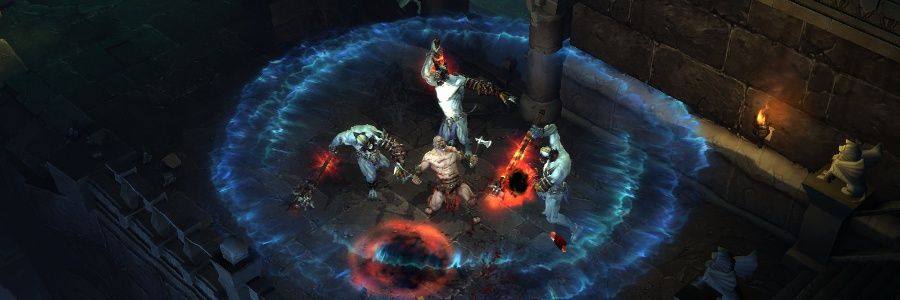This is going to be an interesting experience for me, because my review of the new video game
Diablo 3 isn't really going to have anything to do with the game itself. But that is fairly fitting, because with
Diablo 3, Blizzard has delivered a product that has almost nothing to do with the game itself either.
Before we get into the meat of the review, then, let's get the game stuff out of the way: it's fine. It's fun even.
Diablo 3 pretty much has everything
Diablo 2 had, except with graphics and an interface that are a decade better. If you enjoyed playing
Diablo 2, chances are you will enjoy playing
Diablo 3, which is basically the greatest version of
Gauntlet ever created. It's fine.

Unfortunately, though, creating a fun game just isn't enough for the folks at Blizzard these days, because instead they've created what is either a revolutionary new gaming model that will change how people play for the next decade or more, or they've created the ultimate online pyramid scheme. Or both.
At issue is a little thing you may already have heard about in regards to
Diablo 3, namely the fact that you have to log into the Blizzard servers and play online even if you are playing a solo, single player campaign. There have been a lot of complaints about this and it received a lot of media coverage when the game was released last month, but after playing
Diablo 3 for a few weeks, I can assure you that as far as Blizzard is concerned, this is definitely a feature and not a bug. And it also drives every single facet of the gaming experience.
That's because here's a deceptively simple reason Blizzard makes you play online: You can't really play the game otherwise. Blizzard has designed the game in such a way that even if you could play it offline, you couldn't, because at higher difficultly levels you are required to interact with other payers in one way or another to progress through the game. And they've brilliantly set this up so that most of that interaction takes place at the true heart of
Diablo 3: The auction house.
See, in
Diablo 3, unlike
Diablo 2, equipment is randomly generated by the mobs when you kill them. That means that if you want to get a specific item, you cannot, say, do Baal runs over and over again until you get the drop, because the bosses in
Diablo 3 have no set loot table. In English, this means that there's never any way of knowing what any monster you fight is going to drop.
And even if you did know, that knowledge would be useless because Blizzard has randomized the stats on all equipment drops. The upshot of this is that when you do get an item, it will have between 1 and 6 random stats from a possible chart of say 15-40 different effects; and each of these stats will then have a random numerical value between 1 and 250 or something.

As you can see, it's all incredibly random, which becomes a major problem when you want to actually get gear that is useful for your character. On lower difficulty levels, finding a piece of gear that boosts one of your stats modestly is enough to get through. But when you get to higher difficulty levels, you need to have gear with stats specifically catered to your character's build. And since finding gear with the exact stats you need is almost literally impossible, the only option players have is to turn to other players who have likewise been getting random equipment they can't use and trade or buy each other's stuff. Aka, the auction house.
Now, here's where things get really interesting. You see, ever since the days of
Diablo 2 (and into Blizzard's other big game,
World of Warcraft), players have bought and sold items (and gold) on the black market. This has always been technically against the terms of service and if you are caught you get banned, but thousands of players still do it all the time. With
Diablo 3, however, Blizzard has decided to co-opt the black market by building it into the game and controlling it themselves, via the brilliantly insidious creation of the Real Money Auction House.
If you want to buy or sell an item for real money, then, you can do it right in game through secure systems that Blizzard has set up themselves. This removes the risk of getting your info stolen by some Chinese hacker. But more importantly, it also potentially makes a mound of money for Blizzard themselves, as they charge a flat $1 service fee for every transaction, along with a 15% additional fee if you sell items using PayPal.
So let's review:
Diablo 3 is designed in a way that requires you to use the auction house, and every time you do, Blizzard takes a piece of the action. In essence, Blizzard has designed
Diablo 3 in such a way that the entire player base becomes gold farmers working for Blizzard.
Of course, there are some benefits to this for the player. One of the main drawbacks of games like
Diablo -- and to a lesser extent MMOs such as
World of Warcraft -- is that there's no real purpose to anything. Once you've finished the story of Diablo 3, you can go through it again on higher difficulty levels, but essentially when you buy or find better equipment, there's no actual point to it. Because the only thing having better equipment does is allow you to go through the game easier and quicker... in order to find more equipment. It can be fun, but it's also a pointless, closed loop that eventually becomes tiresome.
The Real Money Auction House, on the other hand, removes this problem in part, because now there is a reason to keep playing to find that better equipment: You can sell it for real American cash on the auction house. Which in a way is an even more brilliant fact from Blizzard's perspective; after all, you have a highly addictive game franchise played by a population known for obsession and then you add to it the possibility of actually making money for playing?
This does affect gameplay in some unexpected ways as well, though. Previously, when you found equipment in a game that you didn't personally need, you would almost always sell it for gold or trade it to other players in order to acquire equipment that you do need. And you can still do this via the regular, gold based auction house in
Diablo 3. However, let's say you find some great Monk shoulders, but you are playing a Demon Hunter. Are you going to want to use this to buy a better bow for yourself? Or do you sell the item for real money instead?

Here's a real life example: Yesterday I got lucky and found a legendary helmet called Andariel's Refuge. I was playing on my 59 Barbarian, but I also have a 54 Witch Doctor whom I don't play very much and for whom this helmet was a huge upgrade. So what do I do? Sell it for gold and buy something awesome for by Barbarian? Give it to my Witch Doctor? Or sell it for real money?
Obviously, I sold it for real money, making a cool $10.61 as just a side effect of doing something I was already doing just for fun anyway. And it's an obvious but true fact: once you start making real money for playing a fun game you were already enjoying, it becomes much more enticing to play more and continue playing. In the first week of the RMAH, I cleared just over $30 -- and that was just from stuff I either had sitting around my vault or that I found while leveling up alts, without any dedicated farming involved at all.
But is that a good thing in terms of either
Diablo 3 being a good game or the future of gaming itself? Because, make no mistake, if Blizzard ends up making as much money off of this as they seem poised to do, the industry is going to take notice. For instance, that $10.61 I received for the helm was only after Blizzard had already skimmed $2.88 off the top for themselves. And that's just one transaction out of what is probably thousands and thousands every day. Once the money starts rolling in -- Blizzard hasn't yet implemented stuff like buying materials, gold and even characters, which they are going to add later -- how long to you think it's going to take for Blizzard to implement a RMAH in
WoW, for instance? And if it does become a successful model, that means you can look forward to a whole new generation of games that, like
Diablo 3, are designed from top to bottom around the auction house rather than around, you know, actually making a good game.
It's kind of fun. It's fairly addictive. It's almost satisfying. But is
Diablo 3 a good thing for games and gamers?
One thing for sure: It's a great thing for Blizzard's bottom line.
My Grades: As a game it gets an
N/A because
Diablo 3 isn't really a game at all. As perhaps the most well-crafted way to harness the earning power of gamers and trick millions of players into becoming free labor, it gets either an
A+ or an
F- depending on your outlook.



















































